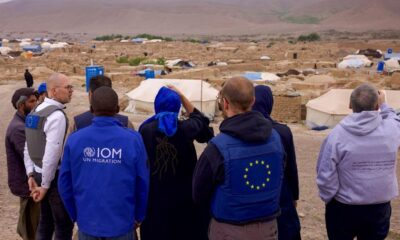Latest News
UNHCR warns of dangerous new era in worldwide displacement as report shows almost 60 million people forced to flee their homes

A UNHCR report, released today, shows that worldwide displacement from wars, conflict, and persecution is at the highest levels we have recorded, and accelerating fast.
UNHCR’s new annual Global Trends report shows a sharp escalation in the number of people forced to flee their homes, with 59.5 million people forcibly displaced at the end of 2014 compared to 51.2 million a year earlier and 37.5 million a decade ago. The increase since 2013 was the highest ever seen in a single year.
The main acceleration has been since early 2011 when war erupted in Syria, propelling it into becoming the world’s single largest driver of displacement. In 2014, an average of 42,500 people became refugees, asylum seekers, or internally displaced every day, representing a four-fold increase in just four years. Worldwide, one in every 122 humans is now either a refugee, internally displaced, or seeking asylum. Were this the population of a country, it would be the world’s 24th biggest.
“We are witnessing a paradigm change, an unchecked slide into an era in which the scale of global forced displacement as well as the response required is now clearly dwarfing anything seen before,” said UN High Commissioner for Refugees António Guterres. “It is terrifying that on the one hand there is more and more impunity for those starting conflicts, and on the other there is seeming utter inability of the international community to work together to stop wars and build and preserve peace.”
UNHCR’s report shows that in region after region, the number of refugees and internally displaced people is on the rise. In the past five years, at least 15 conflicts have erupted or reignited: Eight in Africa (Côte d’Ivoire, Central African Republic, Libya, Mali, northeastern Nigeria, Democratic Republic of the Congo, South Sudan and this year in Burundi); three in the Middle East (Syria, Iraq, and Yemen); one in Europe (Ukraine) and three in Asia (Kyrgyzstan, and in several areas of Myanmar and Pakistan). Few of these crises have been resolved and most still generate new displacement. In 2014 just 126,800 refugees were able to return to their home countries, the lowest number in 31 years.
Meanwhile, decades-old instability and conflict in Afghanistan, Somalia and elsewhere means that millions of people from these places remain either on the move or – and increasingly commonly – stranded for years on the peripheries of society and amid the crippling uncertainty of being long-term internally displaced or refugees. Among recent and highly visible consequences of the world’s conflicts and the terrible suffering they cause has been dramatic growth in numbers of refugees seeking safety by undertaking dangerous sea journeys, including on the Mediterranean, in the Gulf of Aden and Red Sea, and in Southeast Asia.
Half are Children
UNHCR’s Global Trends report shows that in 2014 alone 13.9 million became newly displaced – four times the number in 2010. Worldwide there were 19.5 million refugees (up from 16.7 million in 2013), 38.2 million were displaced inside their own countries (up from 33.3 million in 2013), and 1.8 million people were awaiting the outcome of claims for asylum (against 1.2 million in 2013). Alarmingly, over half the world’s refugees are children.
“With huge shortages of funding and wide gaps in the global regime for protecting victims of war, people in need of compassion, aid and refuge are being abandoned,” said Guterres. “For an age of unprecedented mass displacement, we need an unprecedented humanitarian response and a renewed global commitment to tolerance and protection for people fleeing conflict and persecution.”
Syria is the world’s biggest producer of both internally displaced people (7.6 million) and refugees (3.88 million at the end of 2014). Afghanistan (2.59 million) and Somalia (1.1 million) are the next biggest refugee source countries.
Even amid such sharp growth in numbers, the global distribution of refugees remains heavily skewed away from wealthier nations and towards the less wealthy. Almost nine out of every 10 refugees (86 per cent) were in regions and countries considered economically less developed. A full quarter of all refugees were in countries ranking among the UN’s list of Least Developed nations.
Europe (up 51%)
Conflict in Ukraine, a record 219,000 Mediterranean crossings, and the large number of Syrian refugees in Turkey – which in 2014 became the world’s top refugee-hosting nation with 1.59 million Syrian refugees at year’s end – brought increased public attention, both positive and negative, to questions to do with refugees. In the EU, the biggest volume of asylum applications was in Germany and Sweden. Overall, forced displacement numbers in Europe totalled 6.7 million at the end of the year, compared to 4.4 million at the end of 2013, and with the largest proportion of this being Syrians in Turkey and Ukrainians in the Russian Federation.
Middle East and North Africa (up 19%)
The massive suffering from Syria’s war, with 7.6 million people displaced internally, and 3.88 million people displaced into the surrounding region and beyond as refugees, alone made the Middle East the world’s largest producer and host of forced displacement. Adding to the alarmingly high totals from Syria was new displacement of least 2.6 million people in Iraq, where as a result 3.6 million people were internally displaced as of the end of 2014, as well as 309,000 people newly displaced in Libya.
Sub-Saharan Africa (Up 17%)
Often-overlooked, Africa’s numerous conflicts, including in Central African Republic, South Sudan, Somalia, Nigeria, Democratic Republic of Congo and elsewhere, together produced immense forced displacement totals in 2014, on a scale only marginally lower than in the Middle East. In all, sub-Saharan Africa had 3.7 million refugees and 11.4 million internally displaced people, 4.5 million of whom were newly displaced in 2014. The 17 per cent overall increase excludes Nigeria, as methodology for counting internal displacement changed during 2014 making it a statistical outlier . Ethiopia replaced Kenya as the largest refugee-hosting country in Africa and the fifth largest worldwide.
Long one of the world’s major displacement producing regions, the number of refugees and internally displaced people in Asia grew by 31 per cent in 2014 to 9 million people. Afghanistan, previously the world’s leading producer of refugees, ceded this sorry ranking to Syria. Continuing displacement was seen in and from Myanmar in 2014, including of Rohingya from Rakhine state and in the Kachin and Northern Shan regions. Iran and Pakistan remained two of the world’s top four refugee hosting countries.
Americas (up 12%)
The Americas also saw a rise in forced displacement. The number of Colombian refugees dropped by 36,300 to 360,300 over the course of the year, although mainly because of a revision in numbers of refugees reported by Venezuela. Colombia continued, nonetheless to have one of the world’s largest internally displaced populations, reported at 6 million people and with 137,000 Colombians being newly displaced during the year. With more people fleeing gang violence or other forms of persecution in Central America, the United States saw 36,800 more asylum claims than in 2013, representing growth of 44 per cent.
The full Global Trends report with this information and more, and including data on individual countries, demographics, numbers of people returning to their countries, and available estimates of stateless population is available at http://www.unhcr.org/2014trends.

Latest News
IEA and Syrian FMs hold phone talks, express hope for bilateral ties

The Islamic Emirate's Acting Foreign Minister Amir Khan Muttaqi has held a telephone conversation with Syrian Foreign Minister Asaad Hassan al-Shibani, the ministry said in a statement.
Hafiz Zia Ahmad Takal, the Ministry's deputy spokesman, stated that during the conversation, Muttaqi congratulated the Syrian government on their success, praised their stance on general amnesty and good governance, and expressed hope for the establishment of regular diplomatic relations between Afghanistan and Syria.
Takal added that the Syrian Foreign Minister also expressed hope for the expansion of bilateral ties and for delegations from both sides to meet and engage in discussions.
Latest News
IEA spokesman announces NDC has built a rail for the first time

Zabihullah Mujahid, spokesperson for the Islamic Emirate, has announced that the National Development Corporation (NDC) has successfully built a rail for the first time in Afghanistan.
Previously, Mujahid also revealed that the NDC had produced both a freight truck and a passenger vehicle, further highlighting the corporation's growing role in boosting Afghanistan's industrial capabilities.
Latest News
Qosh Tepa Canal phase 2 surpasses 81% completion

In a significant milestone for Afghanistan's infrastructure development, officials from the National Development Corporation (NDC) have announced that the second phase of the Qosh Tepa Canal in northern Afghanistan is now 81 percent complete, with the construction of its dam progressing steadily at 67 percent. This ambitious project is poised to transform the region, enhancing irrigation systems and boosting agricultural productivity.
The ongoing work on this irrigation project is taking place in the Andkhoy district of Faryab province, where hundreds of machines are actively involved. NDC officials have confirmed that the second phase of the canal will be completed in the coming months.
Nabiullah Arghandiwal, spokesperson for the NDC, stated, “The second phase of the Qosh Tepa Canal is currently 81 percent complete, with thousands of machines and workers engaged in the project.”
Arghandiwal also highlighted the construction of six large bridges along the canal in Balkh and Jawzjan provinces. Two of the bridges are completed, and the remaining four are expected to be operational soon.
Economic experts believe that once completed, the canal will help Afghanistan achieve self-sufficiency in grain production and generate numerous job opportunities in various sectors.
Young workers involved in the project have expressed their satisfaction with the employment opportunities it provides. They are calling on the government to launch similar development projects to combat youth unemployment.
Abdul Ghani, a worker, remarked, “This project is progressing very well, and I urge the Islamic Emirate to implement similar projects.”
It is important to note that the entire funding for the Qosh Tepa Canal project is sourced from domestic revenue.
-

 Latest News4 days ago
Latest News4 days agoOver 50 Afghan inmates freed from Pakistani prisons
-

 Latest News5 days ago
Latest News5 days agoTrump criticizes abandoning of equipment in Afghanistan, vows to rebuild military
-

 World4 days ago
World4 days agoIsraeli defense minister claims responsibility for first time for Hamas leader Haniyeh’s assassination
-

 Latest News4 days ago
Latest News4 days agoJapan, UNDP launch new community resilience programme in Afghanistan
-

 Latest News5 days ago
Latest News5 days agoIOM appeals for nearly $500 million to support Afghans in 2025
-

 Latest News4 days ago
Latest News4 days agoMines ministry signs cement production contract in Logar with private company
-

 Sport4 days ago
Sport4 days agoICC announces schedule for 2025 Men’s Champions Trophy
-

 Latest News4 days ago
Latest News4 days agoPakistani special envoy holds talks with IEA acting interior minister


















